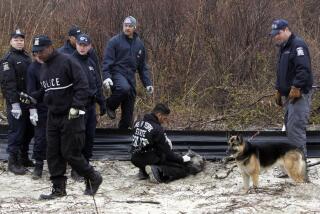Skeleton in the Septic Tank Reopens Mystery of Missing Millionaire
- Share via
HOPKINTON, R.I. — On a September morning in the southwestern woods of Rhode Island, as the maples and oaks were changing into their autumn splendor, Greg Siner noticed a stench while walking by the septic tank of his rambling old Victorian home.
Siner shoved aside the heavy cement lid to see if the tank needed to be pumped.
“I looked in,” he says, “and there was a skull staring up at me.”
Siner rushed into the house to tell Gardner Young, who bought the home with Siner a year ago. Young called police.
Police believe the skeleton in the tank is all that remains of Camilla Lyman, the previous owner of the house, who disappeared a decade ago. They also believe that Lyman, a transvestite millionaire and breeder of champion spaniels, was murdered. After all, there are easier ways to commit suicide than to climb into a septic tank.
What else did investigators find when they siphoned the tank? And who do they think killed Lyman?
Police, concerned about compromising the investigation, aren’t saying. Nor will they confirm rumors that they found cinder blocks wired to the remains.
Lyman’s disappearance didn’t arouse suspicion at first. In fact, there was no official search of Lyman’s 40 acres until John Scuncio, a retired state police detective, took over as Hopkinton police chief a year ago and reopened the long-dormant case. At the same moment that Siner found the skull in the tank, Scuncio was on another part of the 40-acre estate, searching for a body.
Lyman, 54 at the time of her disappearance, was the daughter of Arthur T. Lyman, an affluent Bostonian with more than 30 years’ public service in Massachusetts, including stints as commissioner of corrections and commissioner of conservation.
According to friends and family members, Lyman’s father doted on her and she deeply felt his loss after he died of lung cancer in 1968. Sometime after that, Lyman’s transformation into a man began.
The Brahmin heiress attended national dog shows wearing short hair, a mustache she grew with the help of steroids intended for her dogs, bolo ties and herringbone jackets. In her masculine guise, Lyman bore a spooky resemblance to her father.
Lyman bought the Hopkinton house in 1984. When she wasn’t at dog shows, she had little to do with the outside world. She was cranky to her neighbors. A stockade fence at the front of her property kept out the unwanted. She had grown distant from her own relatives.
“She was cute and perky” in her youth, says Lyman’s sister, Mary Goodale of Boston. “She began to withdraw from us [the family] in the 1970s. I don’t know why.”
A small circle of trusted associates living around Hopkinton took care of Lyman’s practical matters, leaving the heiress to devote herself to her 58 dogs.
One of those associates was George T. O’Neil, a fellow dog breeder from nearby North Kingstown, whom Lyman apparently considered her best human friend. O’Neil cashed Lyman’s checks for her, picked up her mail, had power of attorney over her affairs and was the sole beneficiary in her will, according to testimony at a 1994 probate hearing dealing with Lyman’s estate.
O’Neil didn’t inform police about Lyman’s disappearance, though he conceded noticing in July 1987 that she was missing, the probate records show. But O’Neil did keep maintaining Lyman’s house and taking care of her dogs.
Police learned of Lyman’s disappearance in December 1988, when her brother filed a missing-person report with the Hopkinton police.
George Weeden, then the local police chief, saw no reason to doubt O’Neil’s contention that Lyman frequently went off for extended periods without telling anyone. So Weeden chose not to dig up Lyman’s property to look for her.
Lyman’s brother and two sisters, however, were alarmed. They thought their sister loved her dogs too much to leave them for months. In August 1988, they hired a private investigator to look for her.
Six years later, after the search proved futile, the three siblings went to probate court to have Camilla Lyman declared legally dead--and to keep about $2 million that had been set aside for her in family trust funds from falling into the wrong hands.
In a settlement with the family, O’Neil got Camilla’s Hopkinton property, which was sold to Siner and Young last year, but received no part of the family trust funds.
Hopkinton Probate Court Judge Linda Urso declared Lyman legally dead in June 1995. In her written ruling, Urso said that some “disturbing facts surround her absence,” and called O’Neil’s testimony during the proceedings “not wholly credible.”
“The circumstances surrounding Lyman’s disappearance as described by Mr. O’Neil are sketchy, and his actions for a long period of time thereafter are unsettling,” Urso wrote, noting that “he continued to run Lyman’s affairs as if nothing had happened.”
Charles John Allen, the Boston private detective hired by Lyman’s siblings, said O’Neil told him early in his investigation that Camilla had gone off to Europe for a sex-change operation. Allen had informants in Europe’s transvestite scene snoop around, but no trace of her was found.
Allen says he wanted to search Lyman’s property but O’Neil wouldn’t let him. Allen probed Lyman’s bank accounts to find out what was happening to interest income from her trust funds that was still being paid out after she disappeared.
“It was sort of troubling,” says Allen. “There were fairly large amounts of money that couldn’t be traced.” Allen would not go into details, but said he has given his file on the matter to police.
Contacted by telephone, O’Neil refused to talk with Associated Press. Cranston attorney Roberta Ragosta, who also helped manage Lyman’s financial affairs, has avoided reporters as well.
The Lyman case has been a frustrating one for Allen, whose firm boasts it has located all of the 8,000 or so people it has been hired to find over the years. All but Camilla Lyman.
More to Read
Sign up for Essential California
The most important California stories and recommendations in your inbox every morning.
You may occasionally receive promotional content from the Los Angeles Times.













